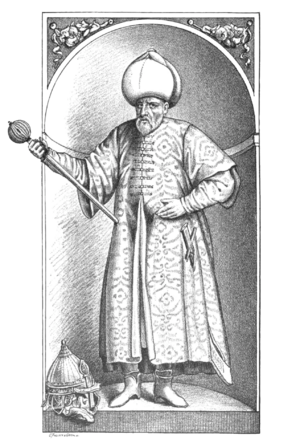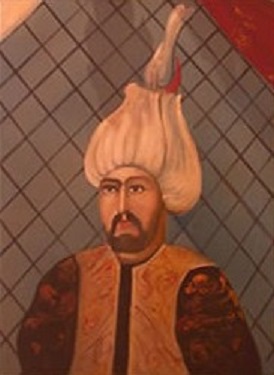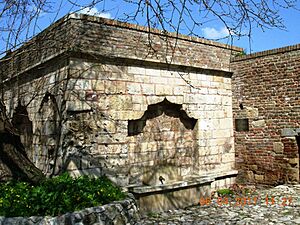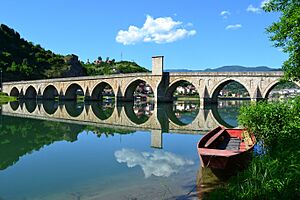Sokollu Mehmed Pasha facts for kids
Quick facts for kids
Sokollu Mehmed
Pasha
|
|
|---|---|
 |
|
| 35th Grand Vizier of the Ottoman Empire | |
| In office 28 June 1565 – 11 October 1579 |
|
| Sultan | Suleiman I Selim II Murad III |
| Preceded by | Semiz Ali Pasha |
| Succeeded by | Semiz Ahmed Pasha |
| Personal details | |
| Born |
Bajica Nenadić
1505 Rudo, Sanjak of Herzegovina, Ottoman Empire (modern-day Rudo, Bosnia and Herzegovina) |
| Died | 11 October 1579 (aged 72–73) Constantinople, Ottoman Empire (modern-day Istanbul, Turkey) |
| Spouse |
Ismihan Sultan
(m. 1562) |
| Children | Safiye Hanımsultan Sultanzade Ahmed Bey Sultanzade Sokolluzâde Ibrahim Pasha Sultanzade Piri Mehmed Bey |
| Alma mater | Enderun School |
| Religious affiliation | Islam (prev. Eastern Orthodoxy) |
| Military service | |
| Allegiance | |
| Branch/service | |
| Years of service | 1541–1579 |
| Rank | Commander of the Imperial Guard (1543–1546) Kapudan Pasha (Grand Admiral; 1546–1551) Governor-General of Rumelia (1551–1555) Third Vizier (1555–1561) Second Vizier (1561–1565) Grand Vizier (1565–1579) |
| Battles/wars | Ottoman–Venetian War (1570–73) Ottoman–Hungarian Wars Russo-Crimean War (1571) Croatian-Ottoman Wars Ottoman–Safavid War (1532–55) Ottoman–Safavid War (1578–90) |
Sokollu Mehmed Pasha (born Bajica Nenadić in 1505) was an important Ottoman leader. He was from a Serbian family and became the Grand Vizier of the Ottoman Empire. This was like being the Sultan's main helper and advisor.
When he was a young boy, Mehmed was taken from his Christian family to serve the Ottoman Empire. This was part of a system called devşirme, where Christian boys were trained to become soldiers or government officials. He rose through the ranks, becoming a commander, an admiral, and a governor. Finally, he became Grand Vizier in 1565. He served under three powerful Sultans: Suleiman the Magnificent, Selim II, and Murad III. He was Grand Vizier for almost 15 years until he was assassinated in 1579.
Even though he became Muslim, Sokollu Mehmed Pasha remembered his family and his Serbian roots. He helped bring back the Serbian Patriarchate of Peć, which was an important religious center for Orthodox Christians. He also helped his family members get important jobs in the Ottoman Empire.
Contents
A Young Boy's Journey
Early Life and Family
Sokollu Mehmed's birth name was Bajica. He was born in a small village called Sokolovići, near modern-day Rudo in Bosnia and Herzegovina. His family were shepherds and belonged to the Serbian Orthodox Church. The name "Sokollu" means "from Sokol" in Turkish, showing where he came from. His father's name was Dimitrije. He had two brothers and a sister.
Even after becoming Muslim, Mehmed remembered his family. He gave important jobs to his relatives, both Muslim and Christian. These included people like Makarije Sokolović, who became a religious leader.
Education as a Janissary
When he was taken into the Ottoman system, Bajica was renamed Mehmed. He received a special education, first in Edirne and then in Istanbul. He started as a young Janissary, which was a special soldier in the Ottoman army. Then he went to the Enderun, a palace school in the Topkapı Palace. This school trained future leaders.
Mehmed learned many languages. Besides Turkish, he could speak Serbian, Persian, Arabic, Italian, and Latin. This helped him greatly in his career.
Starting His Career
In 1541, Mehmed became a close helper to Sultan Suleiman the Magnificent. He learned a lot from the Sultan.
As a soldier, Mehmed showed great skill in battles, including the Battle of Mohács. In 1546, he became the High Admiral of the Ottoman fleet. For five years, he worked hard to make the navy stronger.
In 1551, Mehmed became the Governor-General of Rumelia, a large area in the Ottoman Empire. While visiting his home region, his mother recognized him by a birthmark. It was the first time they had seen each other in over thirty years.
Mehmed led Ottoman forces in Hungary in 1551 and 1552. He captured many cities and showed his strength as a military leader. He even encouraged local Serb soldiers to join his side because they shared the same background.
Later, Mehmed helped in the war against Safavid Persia. He spent the winter of 1553-1554 preparing for the final parts of this war.
Becoming a Vizier
Third Vizier
Sultan Suleiman was very impressed with Mehmed's abilities. In 1555, he made Mehmed the Third Vizier, giving him a place in the Imperial Council. This was a very high position.
Soon after, Mehmed had to stop a rebellion near Thessalonika. He quickly put down the uprising and the leader was caught.
In 1557, Mehmed's brother, Makarije, who was a monk, visited him in Istanbul. They talked about bringing back the Serbian Orthodox Church's independence. Later that year, Sokollu Mehmed helped make this happen. He issued a special order that brought back the Serbian Patriarchate of Peć. His brother Makarije became the new Patriarch. This order also protected the religious freedom of all people in the Ottoman Empire.
Mehmed also helped stop a rebellion led by Sultan Suleiman's son, Bayezid. Bayezid wanted to take over from his brother Selim. Mehmed led an army and defeated Bayezid's forces.
Second Vizier
In 1561, Mehmed became the Second Vizier. This was an even higher position in the government.
In 1562, Sokollu Mehmed married Ismihan Sultan. She was Sultan Suleiman's granddaughter and the daughter of Prince Selim. Mehmed spent the next few years peacefully managing the empire.
Grand Vizier: Top Leader
War with the Habsburgs
In 1565, Sokollu Mehmed Pasha became the Grand Vizier. This was the highest position a person could have in the Ottoman government, right after the Sultan.
Soon after, tensions grew between the Ottoman Empire and the Holy Roman Empire. War broke out, and Sokollu Mehmed Pasha prepared the army. He led the forces towards Hungary.
A battle happened at Szigetvár. It was a very tough fight, and both sides lost many soldiers. The Ottoman forces won, but both commanders died during the battle. Sultan Suleiman the Magnificent died in his tent from natural causes.
Sokollu Mehmed Pasha kept the Sultan's death a secret for a while. He wanted to make sure the new Sultan, Selim II, could take over smoothly. He announced that Suleiman was too sick to do his duties. He then led the army back to Belgrade to meet the new Sultan.
Forty days after Suleiman's death, Sokollu Mehmed officially announced it. He made sure the army accepted Selim II as the new Sultan. He also gave gifts to the soldiers to keep them loyal.
In 1568, Sokollu Mehmed made a peace treaty with the Holy Roman Emperor. The Emperor agreed to pay a yearly amount of money to the Ottomans.
Expeditions and Projects
Sokollu Mehmed was very involved in planning an Ottoman journey to Sumatra in 1567. He paid close attention to all the details. This trip helped create a strong connection between Istanbul and Aceh in Sumatra.
He also had to deal with a big rebellion in Yemen. This uprising was caused by unhappiness with how the region was being managed. Sokollu Mehmed sent a new governor to calm things down.
Sokollu Mehmed Pasha had a big dream: to build a canal connecting the Mediterranean Sea to Suez. He sent experts to see if it was possible. He also wanted to build a canal between the Don and Volga rivers in the north. These canals would help trade and make it easier for Muslims to visit holy cities.
Wars with Other Powers
Sokollu Mehmed Pasha faced challenges from Russia. A plan to connect the Volga and Don rivers by a canal did not go well. An Ottoman fleet was also destroyed by a storm. In 1570, a peace treaty was signed with Russia.
In 1570, he sent an army to conquer Arabia. This helped expand the Ottoman Empire's borders.
In 1571, the Ottoman navy took Cyprus from Venice. This led to a group of European countries forming the "Holy League" to fight the Ottomans. In the Battle of Lepanto, the Holy League defeated the Ottoman fleet.
Sokollu Mehmed Pasha immediately worked to rebuild the navy. By 1572, the Ottoman fleet was strong again. He famously told the Venetian Ambassador, "By conquering Cyprus we have cut off one of your arms; at Lepanto by defeating our navy you have only shaved off our beard. However, you know that a cut-off arm cannot be replaced but shaved-off beard grows thicker."
In 1573, Venice signed a new peace treaty with the Ottomans, accepting the loss of Cyprus. Sokollu Mehmed also kept good relations with other European countries like France and Poland.
Final Years
Sokollu Mehmed Pasha was very wealthy. He received a good salary and also money from other Ottoman officials.
When Sultan Selim II died, Sokollu Mehmed Pasha again kept it a secret until the new Sultan, Murad III, arrived. He remained Grand Vizier, but his power slowly started to decrease. The Sultan's mother and wife began to have more influence.
Sokollu Mehmed Pasha signed many friendship treaties with countries like Venice, Spain, and England. He also made several European states pay a yearly tribute to the Ottoman Empire.
He was against the war with Persia that started in 1578. However, he was overruled. Sultan Murad III also started to remove Mehmed's allies from important jobs.
Death
On October 11, 1579, Sokollu Mehmed Pasha was assassinated. This ended his almost 15 years as the Sultan's main representative. Some people believe the assassin was a Janissary working for Safiye Sultan, Murad III's wife.
He is buried in his own complex in Istanbul, at the Sokollu Mehmed Paşa Türbe. This tomb was built by the famous architect Mimar Sinan. His wife and family are also buried there.
After his death, Sultan Murad III changed Grand Viziers many times. This showed that the Ottoman government became less stable after Sokollu Mehmed Pasha was gone.
His Legacy and Buildings
Sokollu Mehmed Pasha left behind many famous buildings throughout the Ottoman Empire. These include mosques, bridges, and other structures.
The Sokollu Mehmed Pasha Mosque in Istanbul is considered one of the most beautiful smaller mosques. It is known for its lovely design and colorful tiles.
His most famous building is the eleven-arched Višegrad bridge in his hometown of Višegrad. This bridge is so famous that it is the subject of a novel called The Bridge on the Drina by Nobel Prize winner Ivo Andrić.
Sokollu Mehmed Pasha is also remembered for his interest in arts and sciences. He supported artists and worked with important historians of his time.
Other buildings he helped build include:
- The Azapkapi Mosque in Istanbul.
- The Sokollu Mehmed Paşa Kulliyesi, a complex with a school and his tomb.
- Complexes in Luleburgaz and Payas, which included places for travelers to rest.
- Bridges in Alpullu, Luleburgaz, Corlu, Arslanagića Most, and Podgorica.
- Public bathhouses in various cities.
- The Black Mosque in Sofia, which was later turned into a church.
- A mosque and guest house in his home village of Sokolovići.
Family Life
On August 17, 1562, Sokollu Mehmed Pasha married Ismihan Sultan. She was the daughter of Sultan Selim II and the granddaughter of Sultan Süleyman I.
They had one daughter and three sons:
- Safiye Hanımsultan (born 1563). She married her father's cousin, Sokollu Mustafa Pasha.
- Sultanzade Ahmed Bey (1564 - 1567). He died as a baby.
- Sultanzade Sokolluzâde Ibrahim Han Paşah (1565 - 1621).
- Sultanzade Piri Mehmed Bey (1566 - 1567). He also died as a baby.
Sokollu Mehmed's nephew, Sokollu Mustafa Pasha, was also an important politician. He was a governor in Bosnia for a long time.
Images for kids







